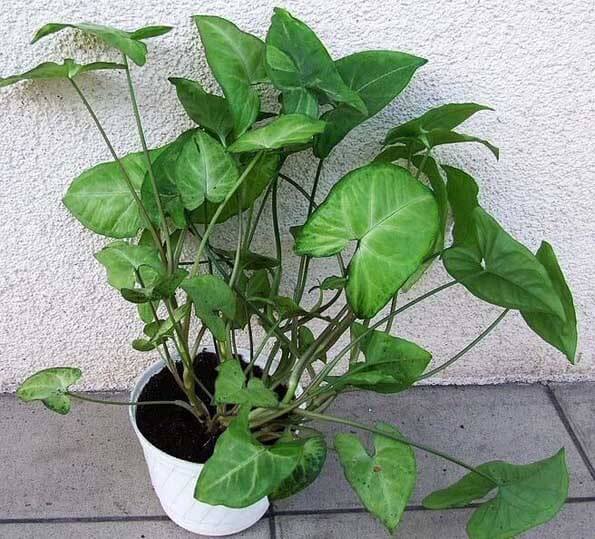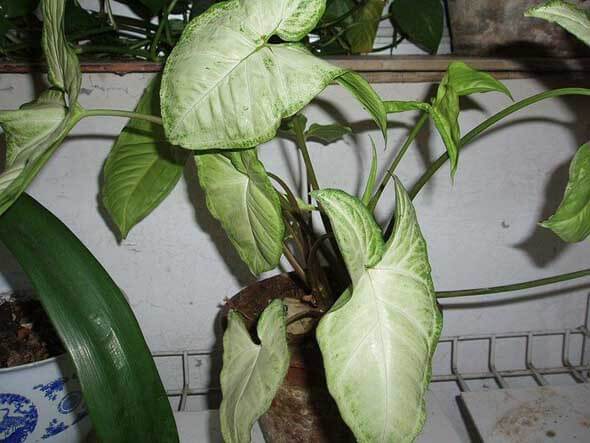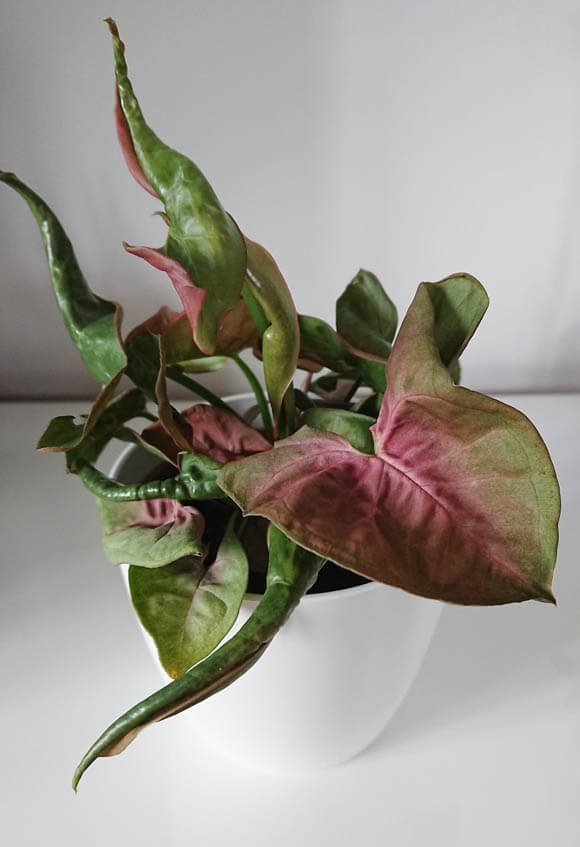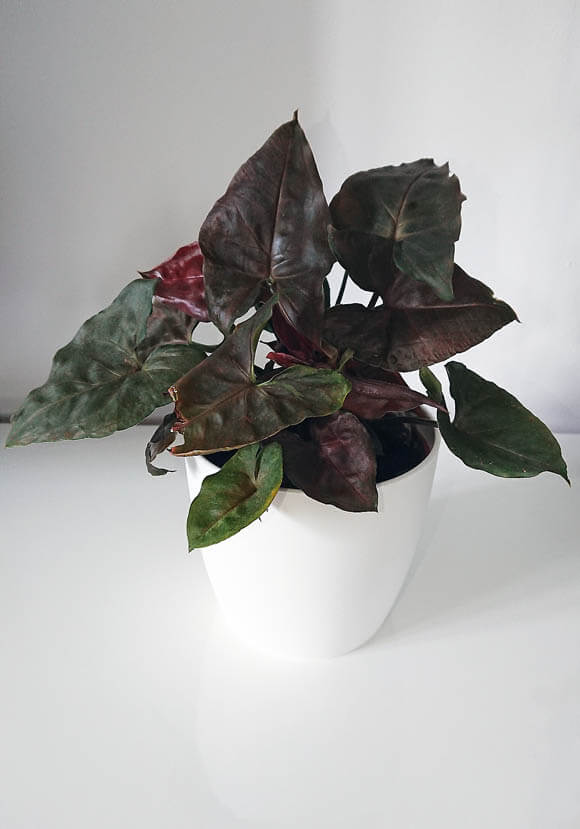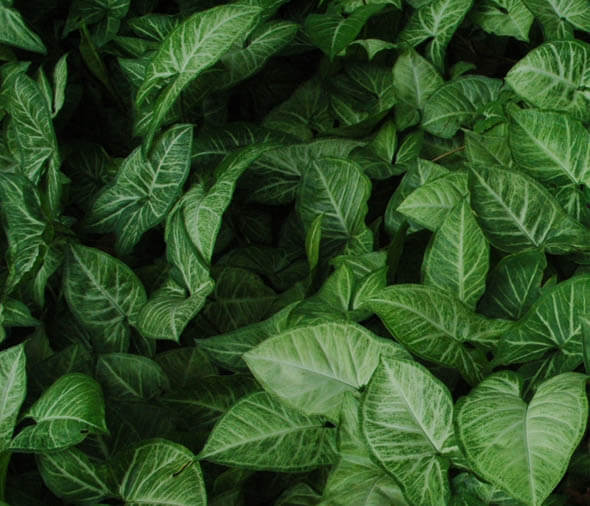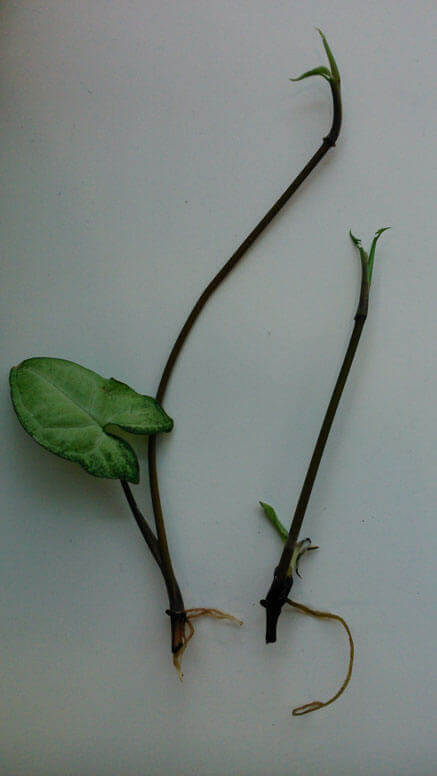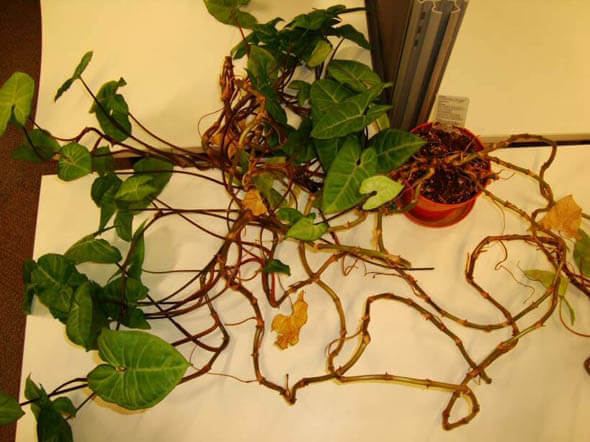Syngonium podophyllum or the Goosefoot Plant / Nephthytis is a simple yet elegant and versatile houseplant to have in your home. Great for those just starting out and still desired by the more experienced indoor plant owners.
This is a great looking indoor plant that only needs basic care
On our scale of Easy, Intermediate or Difficult, we ranked it Intermediate.
It's actually really "easy" to look after in most homes, however, because it has an unruly nature and tendency to creep around your home (if allowed), it needs a certain amount of maintenance and pruning that other plants ordinarily don't.
The pruning is needed to keep a Syngonium living indoors handsome looking and to avoid the ugly flop effect. Also because the plant is slightly poisonous you really do want to know where all parts of the plant are growing and creeping around, especially if you have curious children or hungry pets around.
How do you pronounce Syngonium podophyllum correctly? Say:
Sin-GO-nee-um Po-do-FI-lum
So let's get down to business and lay down six-plus points about this interesting looking plant. Firstly, it ranked in Dr Wolverton's top 50 houseplants to clean the air.
Secondly, it's rarely troubled by pests and doesn't object too much if you throw the occasional bit of neglect its way.
Thirdly, it has amazing foliage with a variety of different variegation on the leaves. The cultivars you can buy are quite diverse although "White Butterfly" (below) is considered one of the best looking and consequently is one of the most popular.
Syngonium - White Butterfly
"White Butterfly" has an almost washed-out appearance, but it's a subtle and less intense green than many other houseplants so can stand out against dark coloured walls and backgrounds. Keep a lookout though for "Imperial White" and "Emerald Gem" both of which also have a striking appearance.
If you're after something a bit more unusual or a little more "modern" then you're in luck because there are several newer varieties of Nephthytis that have become popular over the last few years. In our experience they tend to be a bit slower growing, but this is compensated by the standout markings and colorings. Keep a lookout for these beauties.
Syngonium's are no longer just green and white. This one is green and pink
"Pink Syngonium" and "Neon Robusta", both have light lime green leaves with a good dose of pink scattered throughout the leaves. It's very attractive and draws some serious attention when it gets to a bigger size.
Pro Tip - Although there are lots of newer varieties out there, the care requirements are very similar. So if you have one already growing happily, it's a safe bet any of the others will fit in just fine too.
Another cultivar that proved impossible for us to pass by, was "Maria Allusion". Initially, it can be quite easy to overlook, but on closer inspection, it's really very unusual. If you think that the traditionally grown Syngoniums were normally all about the light green and whites markings. So for a plant which has dark green and dark pink, almost marron colourings make for something really special.
No Syngonium should be particularly expensive and should sit on the lower end of houseplant prices. The exception to this would be if you're buying a very large plant or have picked out a rare variety.
Syngonium Maria Allusion stands out as it has uncommon colourings
The fourth plus is its versatility in that Syngonium can be grown easily as a compact bushy looking plant, or you can accept its creeping, climbing nature and grow it tall up against a moss stick. It also plays well with other plants so if you want to grow several different types of houseplants together in one large container you can do.
It's cheap to buy and very easy to propagate more plants is our fifth plus.
Our sixth and final selling point is how it's always evolving and changing its appearance. A young plant or new leaves will give you arrowhead-shaped leaves, with strong, bold variegation. As your plant ages, the leaves change shape to give a lobed finish. So if you compared a recent cutting with its parent you may even think they're different plants entirely.
This is a really attractive houseplant to have in your home. It's pretty easy going and does best if not fussed constantly (great for the indoor gardener who wants an easy life). They do however need a bit of pruning occasionally as very bushy plants can sprawl and look messy.
This photo by Ine Carriquiry helps demonstrate the gorgeous shapes and leaf patterns on these plants.

Hi, I'm Tom!
If you're like me and enjoy the challenge of growing houseplants and getting them to thrive, then Ourhouseplants can help. This website shares my knowledge and years of growing plants and provides (hopefully) helpful advice on properly caring for your indoor plant friends.
It doesn't matter how you're displaying your Syngonium or choosing how to grow it when it comes to the light requirements, these plants do best in a position where they receive good light with no direct sunlight.
Just remember to water well and then wait. Simple.
This is a fairly thirsty houseplant, especially if it's in a small container or pot. Younger plants will need much less water, but bigger plants will need much more frequent watering, potentially several times a week if the temperature is very warm.
When you go reach for the watering can, the soil needs to be evenly moist when you're done. Then wait for the soil to dry a little before evenly watering again.
Pro Tip - This plant has a similar trait to the Peace Lily in that it will droop quite a bit when it's thirsty. It's less forgiving than it's cousin though, so if you spot the drooping, give it a drink as soon as you notice it happening.
This means you should avoid the "little and often" approach, just remember to water well and then wait. Simple.
In Winter, the "wait" period will increase as the plant will take longer to dry out so adjust accordingly.
Average room conditions are fine, but if you're thinking of putting your plant above a radiator be careful. In growing conditions like this, low humidity levels will become an important issue for Syngoniums because very dry air will encourage brown leaf crisping. If not addressed, the browning can be quite significant which will then distract from the beautiful leaves.
All the usual ways of increasing humidity can be used to help prevent this. Failing that move your plant away from the source of heat. You can always move it back during the months when you're no longer using your heaters.
It's good to try and feed an established growing plant a few times a month.
Like most houseplants, Syngoniums do "rest" in Winter but for only a short period, so even in the middle of the coldest months of the year (providing the indoor room is warm) it's still quite normal to see new leaves emerging.
Therefore it's fine to feed in Winter too if you want. But only if the plant is growing and therefore has need of the fertiliser. If in any doubt don't bother.
This is one houseplant that needs to be at the heart of your home.
When considering placement for these plants, this is one houseplant that needs to be at the heart of your home because it demands warmth, even in cold months. An unheated conservatory in Winter for example is a no-no. A minimum of 16°C (61°F).
As with a lot of climbers, there is often considerably more green growth creeping around the place compared to what's happening underground with the roots. For this reason, they do pretty well in small pots and if you're feeding frequently they do well like this for several years.
However if you notice you're watering more frequently or growth has stopped (and you want more), repot your plant into a bigger pot during Spring using any standard compost mix.
Propagating a Syngonium is easy peasy. You can root cuttings in water, or straight into potting compost. Both methods have a good success rate - providing you cut the right part of the plant.
Syngonium propagation is super easy to do
To get started you want a new growth shoot that either has one or two leaves already, (or the formation of one). They don't have to be brand new growths, as it works with mature shoots too, but we personally have always had better luck with the newer ones.
Follow the growth shoot downwards several inches until you reach a pair of "nodes", these are a set of two small protruding bumps (one on each side of the stem).
Not sure what we mean? - Have a closer look at the photo above or in the picture Gallery and if you look closely towards the bottom of the stems, you can see the small dark nodes sticking out. This is where the roots will form.
The cut needs to be made just a few centimeters below the nodes because this is where the new roots will come from.
If you're rooting using water, it's just a case of dropping the cutting in and keeping the water topped up. A few weeks later you will hopefully start to see new roots. Wait until you have a network of roots before carefully potting up in a free draining compost mix.
If you have opted to plant the cuttings straight into compost, then it's a good idea to dip the cut ends into a rooting hormone first. Put the cutting(s) towards the edge of the pot rather than in the very center, keep the soil moist and place it somewhere warm.
For best results take multiple cuttings at the same time but don't let them touch each other.
A Syngonium will grow steadily for much of the year providing it has good conditions. Left unchecked a stray vine can creep several feet in only a few months.
As with many creepers and climbers you have to exercise a level of control and authority by pinching out (cutting off the tips of the) stray growing vines, otherwise you end up with an unruly and messy looking plant.
A well trained mature Syngonium growing up a moss stick for several years will, as a guide, give you the following maximum dimensions: 1.8m / 6ft in height and a spread of 60cm / 2ft.
Plants grown with no height support won't grow very tall at all, although you can still expect a bushy looking plant if you keep pinching the tips out.
There are flowers which appear on mature Syngoniums, although they aren't very exciting or interesting. The key selling point of this particular houseplant is the foliage.
Yes, the Syngonium is considered a little toxic to most pets in view of the calcium oxalates found in the plant's sap. Consuming the leaves can result in oral irritation and if fully ingested, vomiting is a common side effect.
If the juvenile looking foliage along with a more compact plant is preferred, cut off all the climbing stems that develop — this will keep it bushy and neat. The leaves will be arrow-shaped rather than the adult lobed style.
Good Light Needed They need a moderately lit or brightly lit space. Avoid direct sunlight.
Moderate Watering Water really well then wait until the soil has almost dried out before watering again.
Warm Temperature To do well they need temperatures above 16°C (61°F) at all times.
Feeding Feed once or twice every month all year round providing your plant is producing new leaves and shoots. If it's not, stop feeding.
This happens if pruning, general maintenance and training have been avoided for a long period. Have a look at the photo below to understand what we mean.
Things can get out of hand if you don't train or prune from time to time
Either repot the entire plant, installing a moss stick at the same time and then train and pin the stems to the stick. Otherwise, take cuttings and start again. - See Anything Else for how to keep the plant bushy and compact.
Crispy brown Syngonium leaves
A very common symptom of low humidity.
Variegation changing
For many houseplants, this is a result of incorrect light conditions over a prolonged period. This may be the case here too, but remember the leaves of Syngonium's change as they mature, both in shape and variegation, so these changes could be normal.
Pests
Pests are thankfully quite rare. Generally you only need to watch out for Spider Mites and Aphids.
Credit for the first "Emerald Green" photo - Article / Gallery - Jerzy Opioła
Credit for "White Butterfly" - Article / Gallery - Fanghong
Credit for close up of the Syngonium leaves - Article / Gallery - Ine Carriquiry
Credit for Syngonium with dark green leaves - Gallery - Omegatron
